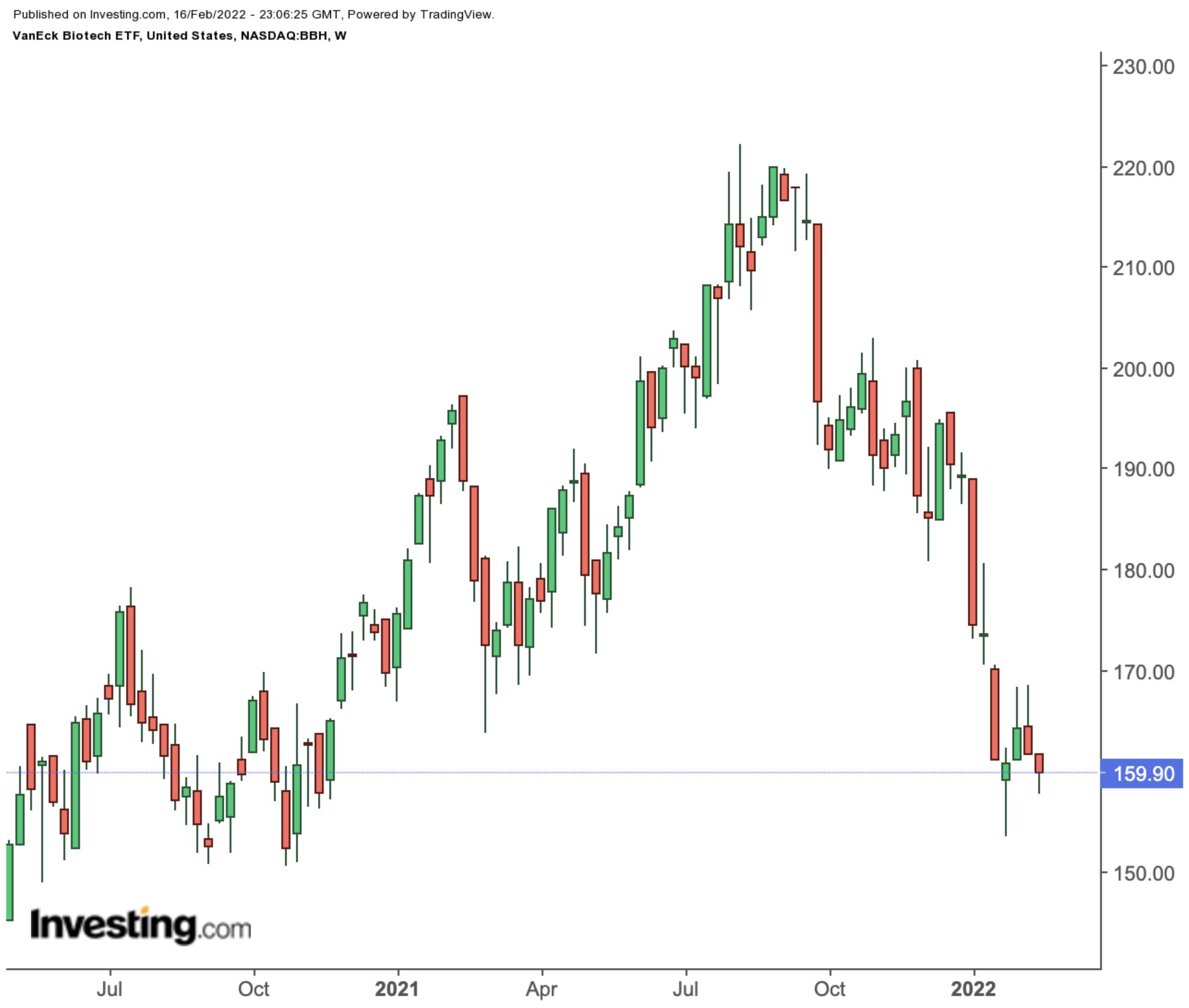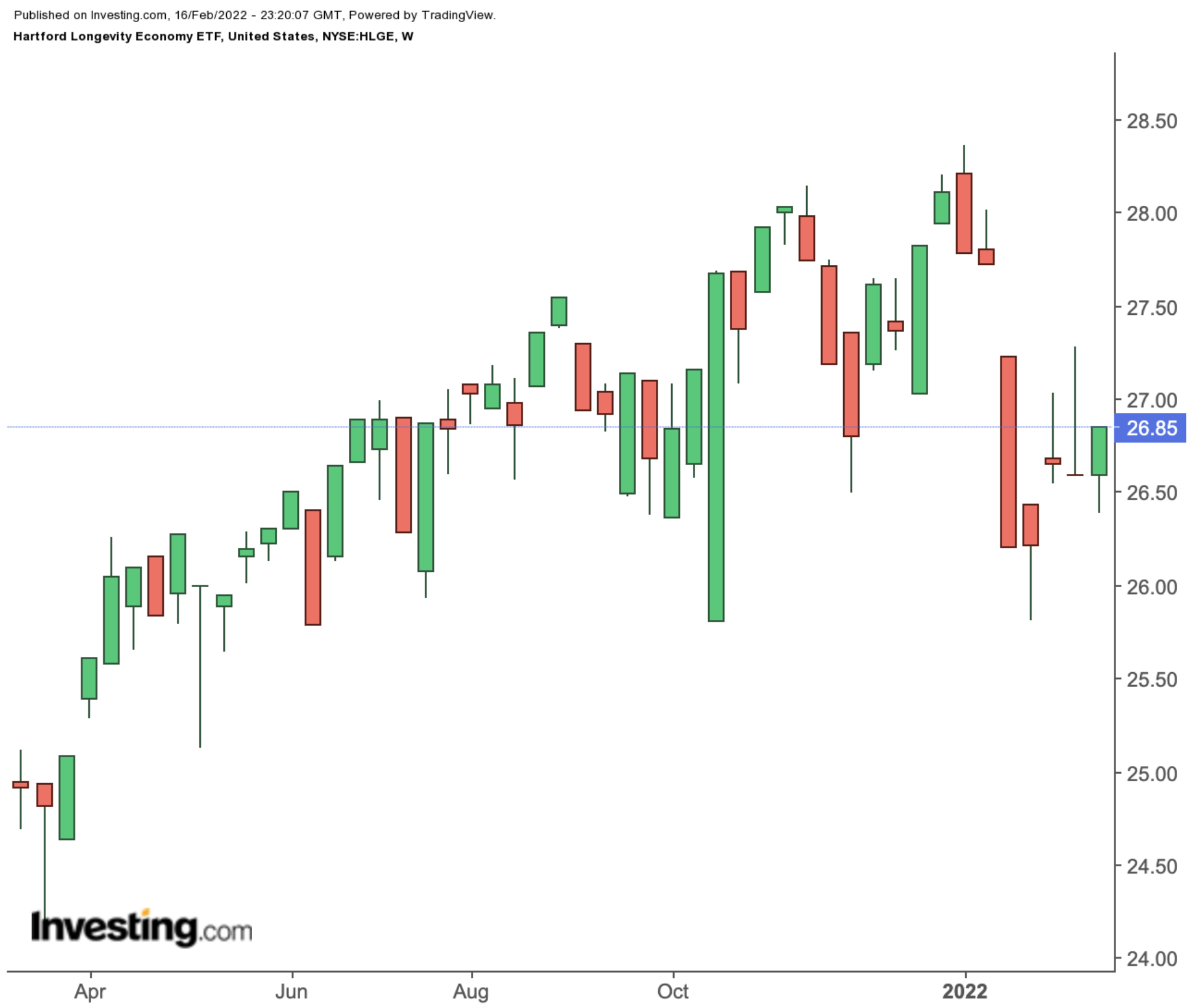Wall Street seems to have eyes only for two things at the moment: the potential next move by the Federal Reserve and geopolitical tensions between Russia and Ukraine. Meanwhile, many stocks and exchange-traded funds (ETFs) have been distressed, losing a significant portion of their market shares.
The Dow Jones Biotechnology Index declined 3.7% in the past 12 months and 9.8% year-to-date. Nonetheless, recent metrics suggest that between 2021 and 2028, the global biotechnology market could grow at a compound annual growth rate (CAGR) of over 15%. Therefore, we can expect stocks in the sector to recover in the coming months and possibly make new highs.
Long-term investors may see this environment as an opportunity for finding better entry points into quality assets.
Today, we introduce two funds that have lost value in recent weeks. Our focus is biotechnology and healthcare names in particular. We believe these sectors deserve to be on watchlists of buy-and-hold investors.
1. VanEck Biotech ETF
- Current Price: $159.90
- 52-Week Range: $153.39 - $222.22
- Dividend Yield: 0.25%
- Expense Ratio: 0.35% per year
Our first fund, the VanEck Biotech ETF (NASDAQ:BBH), invests in biotechnology names that mainly develop therapies based on genetic studies. These companies may also work on diagnostic technologies. The fund was first listed in December 2011.

BBH, which tracks the MVIS US Listed Biotech 25 Index, currently has 25 holdings. The leading 10 names comprise about 65% of net assets of $472.3 million.
Around 90% of the stocks come from the US. Next are biotechnology names from Ireland, Germany, China, and Switzerland.
Amgen (NASDAQ:AMGN), Gilead Sciences (NASDAQ:GILD), Moderna (NASDAQ:MRNA), Vertex Pharmaceuticals (NASDAQ:VRTX), Regeneron Pharmaceuticals (NASDAQ:REGN), and IQVIA (NYSE:IQV) lead the names in the portfolio.
BBH declined 16.5% in the past 12 months and 14.2% since the start of 2022. Put another way, most of the declines came in the new year. In fact, the ETF had hit a record high in August 2021.
Since then, the fund is down around 28%. Trailing P/E and P/B ratios are 18.54x and 5.58x. Potential investors could consider buying around $155.
2. Hartford Longevity Economy ETF
- Current Price: $26.85
- 52-Week Range: $24.19 - $28.36
- Dividend Yield: 2.09%
- Expense Ratio: 0.44% per year
Our next fund is a thematic one with a healthy, long, and prosperous life focus, or the “longevity economy.” Thus, it is not a healthcare pure-play since it invests across several industries.
By 2040, around 80 million Americans will be 65 or older, up 45% from the current approximate 55 million. According to the U.S. Department of Labor, this group spends an average of $3,000 a year per person in healthcare—the most among any demographic.
Likewise, in Europe, the spending power of people aged 60 or older is forecast to reach $5 trillion by 2030. Wall Street pays attention when we have such strong global growth in population and spending power.
The Hartford Longevity Economy ETF (NYSE:HLGE) invests in companies that could benefit from the buying power of the aging global population. The fund started trading in March 2021.

HLGE currently holds close to 200 companies. The top 10 holdings comprise around 10% of net assets of $25.5 million. In terms of sub-sectors, we see information technology (29%), health care (23%), consumer discretionary (15%), communication services (12%), financials (12%), and consumer staples (4%).
Health benefits giants Anthem (NYSE:ANTM) and UnitedHealth Group (NYSE:UNH); consumer technology name HP (NYSE:HPQ), pharmaceutical group AbbVie (NYSE:ABBV), electronic data storage provider Seagate Technology (NASDAQ:STX); and Alphabet (NASDAQ:GOOGL) are among the leading names on the roster.
HLGE hit an all-time high on Jan. 4, 2022. However, since then, the fund has lost over 5.3%. Nonetheless, since its inception almost a year ago, the ETF is still up about 8.2%.
P/E and P/B ratios are 15.0x and 3.1x. We like the diversity of funds, which deserves further due diligence.
